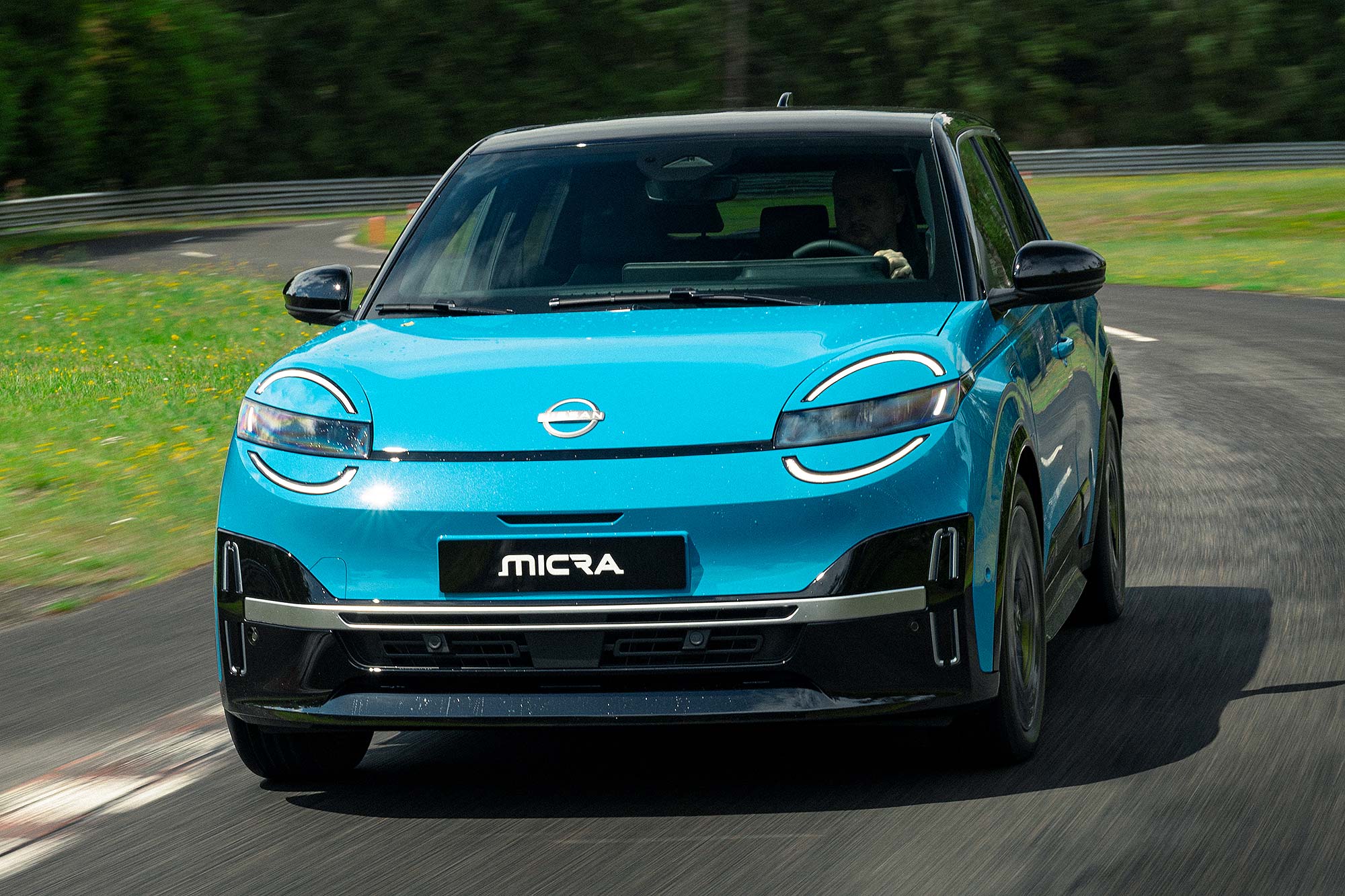Nissan Micra Review 2025: Price, specs & boot space
Written by Richard Aucock
Quick overview
Pros
- Many of the same attributes as the Renault 5 E-Tech
- Classy styling and colour options outside and in
- Price-matched to the Renault 5 E-Tech
Cons
- Doesn’t have the visual charm of the Renault 5
- Interior really shows its Renault roots
- No hot hatch version… yet?
Verdict: Is the Nissan Micra a good car?
“The new Nissan Micra is a more mature take on the smash-hit new Renault 5 E-Tech. It shares much of the same tech, including batteries, electric motors and interior, but has a more refined and understated air. With identical pricing, it’s an interesting alternative for those who find the Renault 5 E-Tech too stand-out.”
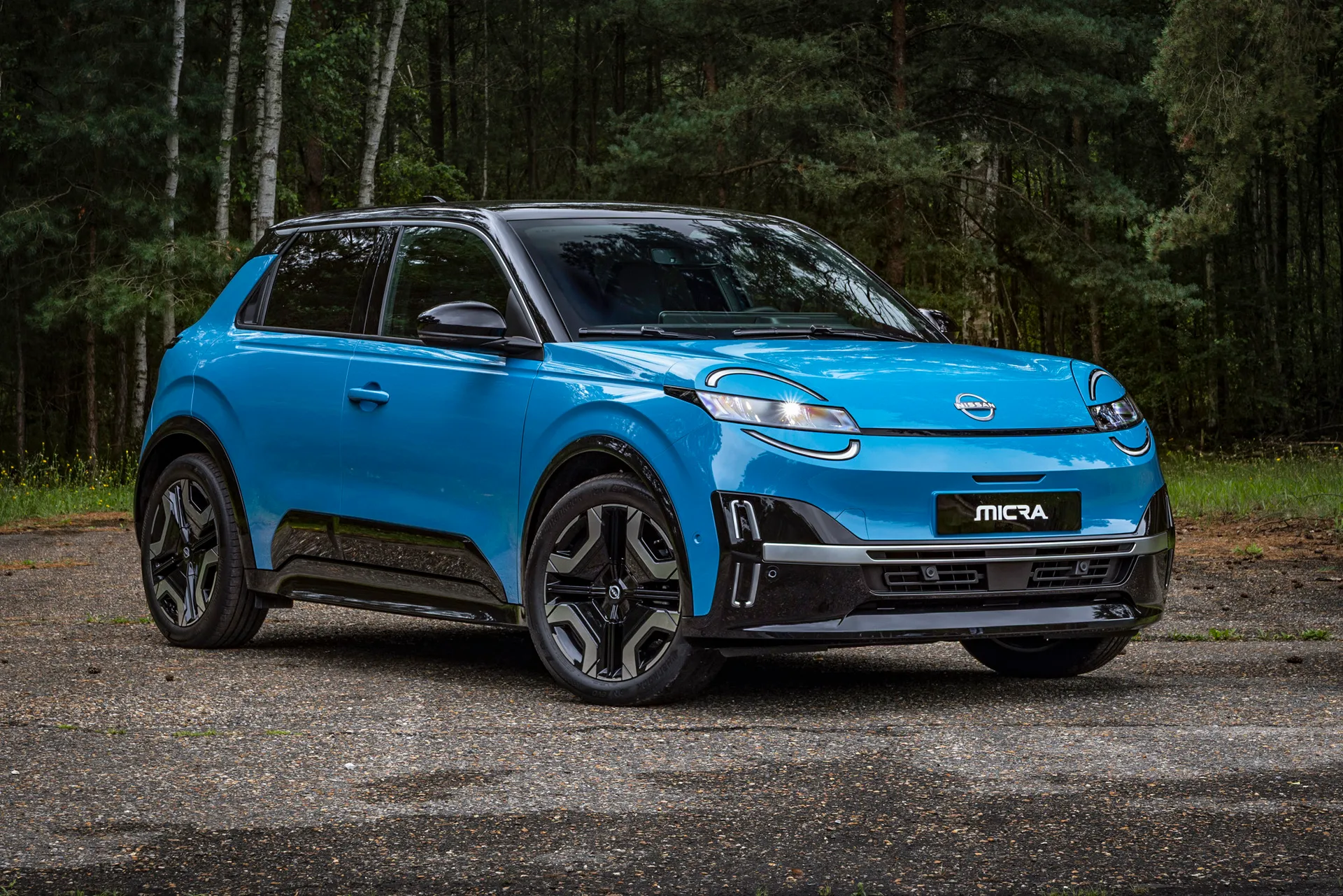
The Nissan Micra is an alternative take on the Renault 5 E-Tech. The two companies shared development, with Renault taking the lead on engineering but offering Nissan the opportunity to create a bespoke exterior design. The stylists jumped at this, and have created a distinctive-looking machine that has a character distinct from the Renault 5 E-Tech.
The Nissan Micra has a more upright front end, making it appear more grown up, and the side profile is ‘quieter’, with a characterful feature line running from front to rear. The highlights are the big, round LED front and rear lights, which hark back to classic Nissan Micras, while a subdued palette of six colours eschew the vivid yellow and green of the Renault 5 E-Tech for more mature silver, white, black, blue and red.
It's the same story inside, where the Nissan Micra blends the Renault 5 E-Tech cabin with calmer, more zen-like colours and trims. What Nissan doesn’t alter is the core technology – and rightly so, because the Renault 5 E-Tech has already won plaudits for its electric car finesse and leading-edge infotainment technology.
The Nissan Micra has a similarly decent electric range – up to 260 miles with the larger of two battery choices – can use public rapid chargers at a decent rate, and has a similarly comprehensive smartphone app to make day-to-day life with an EV that bit easier.
Nissan has even chosen to match Renault on pricing for the new Micra, meaning the choice is down to you. Do you want vibrancy and excitement, or a more mature and grown-up approach? If it’s the latter, the Nissan Micra may well be of interest…
Looking for a used car for sale? We've got 100s of Nissan Approved Used Cars for Sale for you to choose from, including a wide range of Nissan Micra models for sale. If you're looking for the older version, you need our Nissan Micra (2017-2022) review.
Is the Nissan Micra right for you?
The Nissan Micra is another smart option in the belatedly-growing small electric car sector. Its sister car, the Renault 5 E-Tech has obviously helped shine the spotlight on this type of car, and the Nissan Micra offers all the same attributes including a generous standard spec, good driving dynamics, a useful range of over 200 miles and reasonably rapid DC charging times for longer journeys.
As explained, the Nissan Micra has a more understated feel than the Renault 5 E-Tech. The focus is more on luxury and refinement, with different colourschemes and a less outlandish design. This makes it a nice alternative to the Renault 5 E-Tech.
As a small car, the Nissan Micra is best for two people or those with small children. The boot is OK, but the rear seats are on the cramped side, and getting in and out is a little tricky too. If you’re after a more family-focused small electric car, you might be better off looking at models such as the Citroen e-C3 or Hyundai Inster.
We think the Nissan Micra with the larger 52kWh battery is the best choice. It gives the useful reassurance of a 260-mile range, and only costs £2000 more than a mid-grade Advance model with the 40kWh battery.
We also think Advance offers the ideal spec, particularly because it comes with a heat pump and Google built-in infotainment as standard. The only things we’d miss would be the heated seats and steering wheel fitted to top-spec Evolve, but they’re not deal-breakers.
What other cars are similar to the Nissan Micra?
Of course, the Renault 5 E-Tech is very similar indeed to the Nissan Micra. The two are basically the same car, after all, and even have identical pricing. If you like the idea of the Renault 5 but find its retro style a bit too much, the Nissan Micra is a great alternative – and vice-versa.
Other alternatives include the Mini Cooper Electric, which is perhaps the closest rival to the Nissan Micra and Renault 5 E-Tech. The Fiat 500 Electric and Abarth 500e are compact city EVs too, as are the budget Dacia Spring and Leapmotor T03, while the Citroen e-C3 is a slightly larger supermini EV.
The Peugeot e-208 and Vauxhall Corsa Electric are roomier alternatives, although they do also cost more. If you want space without forking out too much, the BYD Dolphin Surf could be worth checking out, and the Hyundai Inster is a stylish choice too.
Comfort and design: Nissan Micra interior
“The Nissan Micra shares a basic interior with the Renault 5 E-Tech, although Nissan has chosen classier and more understated trims and colourschemes for those seeking a less vibrant, more refined air.”
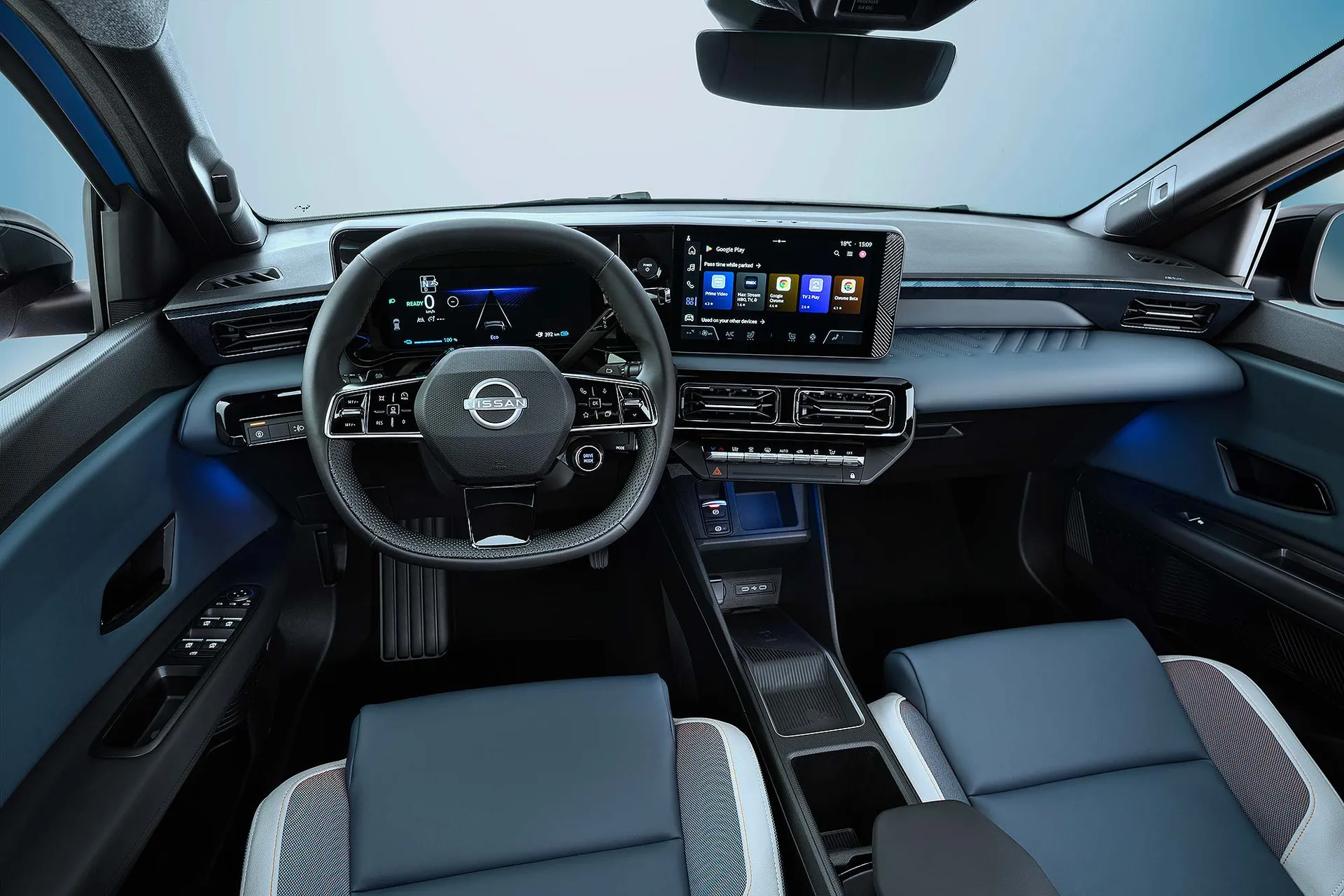
The Nissan Micra shares an interior with the Renault 5. Unlike the exterior, there are few changes to the overall design, with the differences largely coming in colour and trim materials. This means that the Nissan Micra has the same high dashboard, combined with a shallow-looking windscreen, fairly low roofline and high sides. It can make it feel a little dark inside, compared to the open-plan feel you get in, say, a Hyundai Inster – particularly if you choose Engage and Advance models which have a gloomy black interior colour scheme.
The seats are positioned quite high in the Nissan Micra. This gives a good view forwards, helped by a bonnetline that’s higher than in the Renault 5. You get a better impression of where the front end is, which could help with parking and manoeuvring in tight spaces.
The compact, wraparound feel of the driving position places most of the controls within easy use. We’re delighted to see Nissan continues with Renault’s physical heater control buttons, which are tactile and very easy to use. Even the button on the steering wheel to change driving modes is easy to find and operate.
Quality and finish
The Nissan Micra’s doors make a bit of a clang when you close them, but once inside, quality holds up. Plastics are perfectly acceptable for a car in this price bracket and the extensive use of different materials on the dashboard and door trims gives it an upscale feel.
It looks particularly well-finished in the top-spec ‘Chill’ trim that’s available as an option on Evolve grade. We also like the blue denim-style ‘Audacious’ upholstery that’s standard on Evolve. The ‘Modern’ black cloth trim of Engage and Advance seems a little plain in comparison.
The gear selector is mounted on the right of the steering column. It’s a column stalk-style lever, that some might confuse for the wiper stalk at first. It’s also odd that there’s no ‘park’ or ‘P’ mode. When you stop the car, you hold the brake pedal and shift into ‘neutral or ‘N’, and the car applies the electric parking brake automatically.
The steering wheel is nice to hold but it’s a shame the Nissan Micra has touch-sensitive buttons. Not only are they awkward to use, but they feel a bit cheap.
Infotainment: Touchscreen, USB, sat nav and stereo in the Nissan Micra
All Nissan Micra have the same 7.0-inch TFT driver display and 10.1-inch central infotainment screen. The centre screen isn’t the brightest around, but it’s still decent, and works particularly well when paired with a smartphone via the standard Apple CarPlay and Android Auto. Both are wireless – although you only get a wireless smartphone charger in Advance grade and above. Engage owners will have to rely on the two USB-C charge ports (there are no USB ports in the rear).
Pick Advanced grade and above, and the Nissan Micra features Google built-in infotainment technology. This includes Google Maps (with an intelligent route planner to optimise efficiency and, where necessary, automatically find EV chargers en route – even heating the battery up to precondition it ahead a charging stop), Google Assistant and Google Play Store.
The Google built-in tech means that if you log in with your Google account, everything will be synchronised. You can search for locations on your computer and mobile phone, for example, and then send them to your car – and the Nissan Micra system will even pick up on your Google Maps search history.
So equipped, the Nissan Micra infotainment becomes front-running. Access to the Google Play Store allows you to install apps such as YouTube, so you can watch videos on the screen while you charge. The system is also smooth, quick and responsive, with a familiarity you don’t get with many other automotive infotainment systems. The only way it could be improved would be with a crisper, brighter screen.
Space and practicality: Nissan Micra boot space
The Nissan Micra is a small car, measuring less than four metres long, and this does have an impact on interior space. It’s OK in the front, with generously-sized seats and a good amount of adjustment. The compromises are found in the rear.
The fact the Nissan Micra has concealed rear doorhandles, rather than prominent pull-out handles, maybe indicates rear space isn’t a priority. Adults will struggle to get in, as foot space is very tight. They may have to twist their feet sideways as there’s not enough space to squeeze them below the front seat. Knee room is actually not bad, and headroom is OK, but it’s the high floor and lack of foot space that will almost jam adults in place. Those in the front seats will definitely have to compromise.
The Nissan Micra has a 326-litre boot, which is broadly supermini-sized (and much bigger than the Mini Cooper Electric). Again, the space is a bit shallow, but this makes it easy to drop things in and haul them out. Fold the rear seats and space expands to 1106 litres.
Handling and ride quality: What is the Nissan Micra like to drive?
“The Nissan Micra drives in much the same way as the Renault 5 E-Tech, which is no bad thing as the French EV is currently one of the best small electric cars around.”
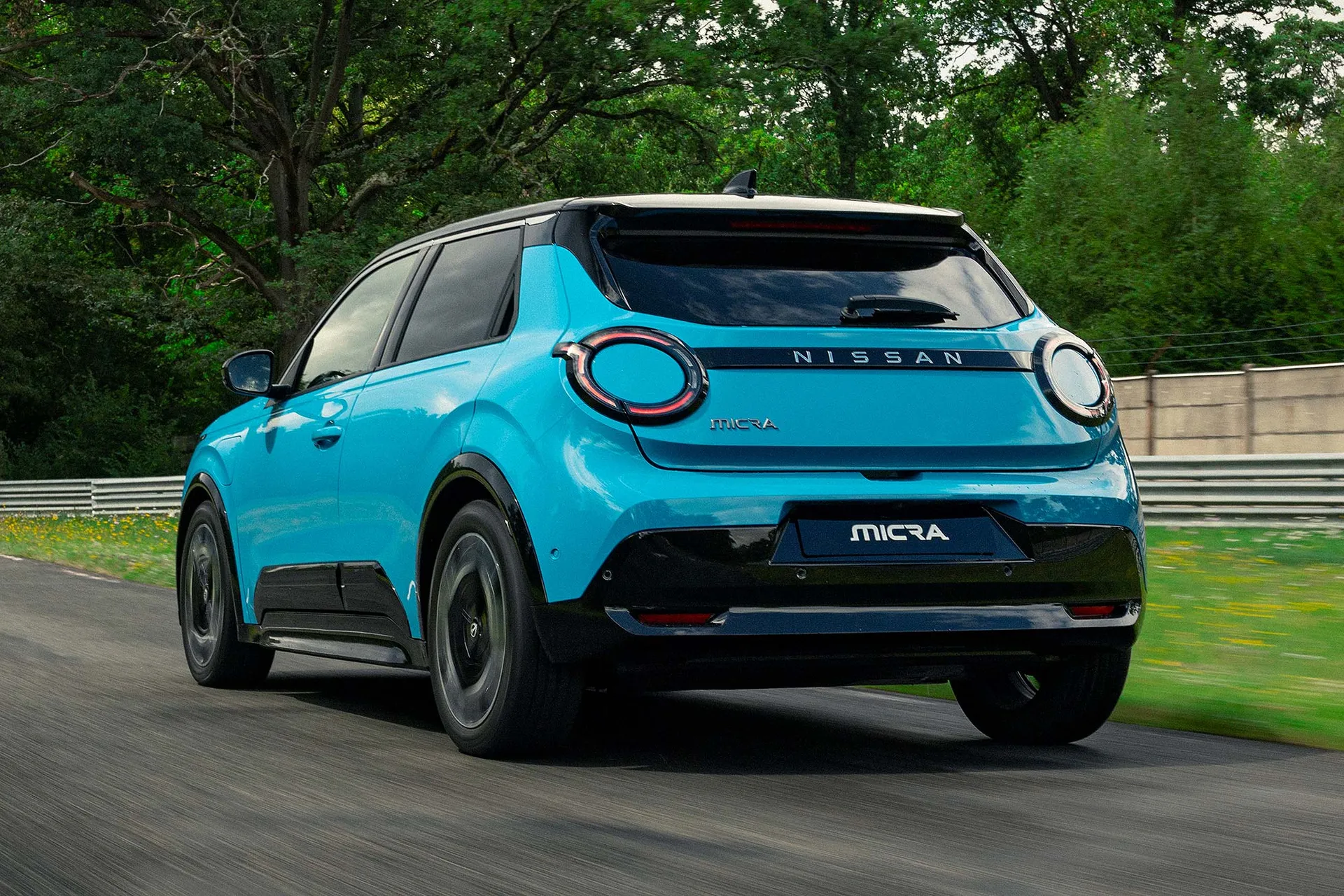
The Nissan Micra is a sophisticated-feeling car to drive. It’s much more grown up than most petrol-powered small cars, which will be an immediate highlight if that’s the car you’re currently driving. Press the accelerator and it pulls away smoothly, and pressing the pedal harder doesn’t lead to any of the snatchy surge you get in some other electric cars. It’s easy to control at all speeds.
The 18-inch wheels are a little on the large side and the tyres can pick up a bit of ripple from road surfaces. It can be noisy over cobbled road surfaces, with a bit of shimmer and shudder. It’s not too bad though, and those bigger wheels pay dividends at speed where the Nissan Micra has a confident, well-planted feel.
Steering is quite heavy in sport mode, perhaps unnecessarily so. This also sharpens up the accelerator. It feels more natural in normal mode, but still with reasonable weight. The steering isn’t nervously quick, as it can be in some small cars, and we found it quite accurate without feeling nervous at higher speeds.
We found the front-wheel drive Nissan Micra feels stable in corners, helped by the fact it has high-end multi-link rear suspension as standard. It turns into bends cleanly and its progressive nature means it’s easy to ‘read’ the handling. It requires minimal inputs and has a grown-up feel. It’s perfect for the target market, although those seeking a bit more verve may be a touch disappointed.
The brakes utilise energy regeneration from the motor. Most of the time, pressing the pedal will ‘reverse’ the motor and slow the car down that way, topping up the battery in the process. It’s only when you press the pedal harder that the regular brakes are called into action.
This is common for electric cars, but it’s a bit snatchier in operation here than some other EVs. The firm feel to the brake pedal perhaps doesn’t help, and you sometimes can feel when it switches between regeneration and regular brakes. Brake sharply and there can be noticeable front-end dive.
What motors and batteries are available in the Nissan Micra?
The Nissan Micra offers a choice of two batteries and motors. The 40kWh battery is paired with a 120PS electric motor, which produces 225Nm of torque. 0-62mph takes 9.0 seconds and it has a 93mph top speed. The 52kWh battery is paired with a beefier 150PS electric motor, with 245Nm of torque. 0-62mph drops to 8.0 seconds, but it has the same restricted 93mph top speed.
We’ve only driven the 52kWh choice, which is expected to easily be the most popular. As mentioned, it feels punchy enough without being over the top. Acceleration is ample even at higher speeds, and it’s only on the motorway where you’ll notice the instant surge when you press sharply on the accelerator is lacking. The 93mph top speed is limited in the interests of conserving range, and won’t be an issue in the UK.
The Nissan Micra 40kWh has an official WLTP range of 198 miles (and official consumption of 4.4 miles per kWh). Take the larger 52kWh battery, and this extends to an official 260 miles and 4.2 miles per kWh. Of course, you probably won’t get that in everyday driving – as with fuel economy, electric range very much depends on how you drive. But you should easily get a dependable everyday range of 210 miles or more with the 52kWh battery – that’s why it’s our pick, as it offers the useful extra buffer to minimise range anxiety.
Impressively, all Nissan Micra come with a heat pump as standard. This is technology that helps improve overall efficiency, especially in particularly hot or cold weather. The fitment of a standard heat pump should mean the range and efficiency remain reliably consistent all year round – you won’t have to waste battery power in winter heating up the interior, for example. It allows the battery to be heated and cooled in order to maximise DC rapid charge speeds, too.
Refinement and noise levels
As an electric car, the Nissan Micra is naturally very quiet. In city driving, the lack of a buzzy little petrol engine serves up big car refinement, and the general smoothness is leagues ahead of traditional small-engined city cars. For this reason, some may like to make the most of it and pick top-spec Evolve with its premium Hardon Kardon stereo.
Apart from the wheels picking up the odd bit of irritation from variable road surfaces, the refinement continues, and it’s even smooth enough at higher speeds. Given its city centre focus, noise levels in the Nissan Micra are more than acceptable.
Safety equipment: How safe is the Nissan Micra?
The Nissan Micra hasn’t yet been tested by safety organisation Euro NCAP. However, the closely-related Renault 5 E-Tech was tested in 2025, scoring a four-star rating. It ranked well for adult and child protection, plus vulnerable road users, but its 68% score for safety assist dipped it just below the level for a full five-star rating.
The Nissan Micra is fitted with a good amount of safety equipment and technology as standard. Autonomous emergency braking is a very useful feature, as are six airbags and emergency lane-keep assist. Lane departure warning and prevention can be a little more irritating in everyday use, and the intelligent speed assist can also annoy – but it could also help you avoid a speeding ticket.
As with many Renaults, the Nissan Micra has a button to the right of the steering wheel that, with just one press, allows you to call up your preferred driver assistance settings. You can choose to disable lane-keep mode plus speed limit alerts, for example, and call them up quickly each time you drive. Legislation requires them to be default-on each time you start up, so this is a smart way to disable them with the minimum of fuss.
The Nissan Micra Advance adds adaptive cruise control with stop and go, a blind spot warning system, rear cross-traffic alert and rear auto emergency braking. There’s a rear-view camera as well. The Nissan Micra Evolve boosts safety tech further with the clever Nissan ProPilot Assist with NaviLink. This automatically adjusts speed limits when adaptive cruise control is set, and decelerates according to the size of the road curve up ahead.
Nissan Micra charging times: How much does it cost to charge?
“The Nissan Micra boasts decent efficiency from its two battery choices, meaning it should go for further on each kWh of charge. If you can charge at home, costs will be very low.”
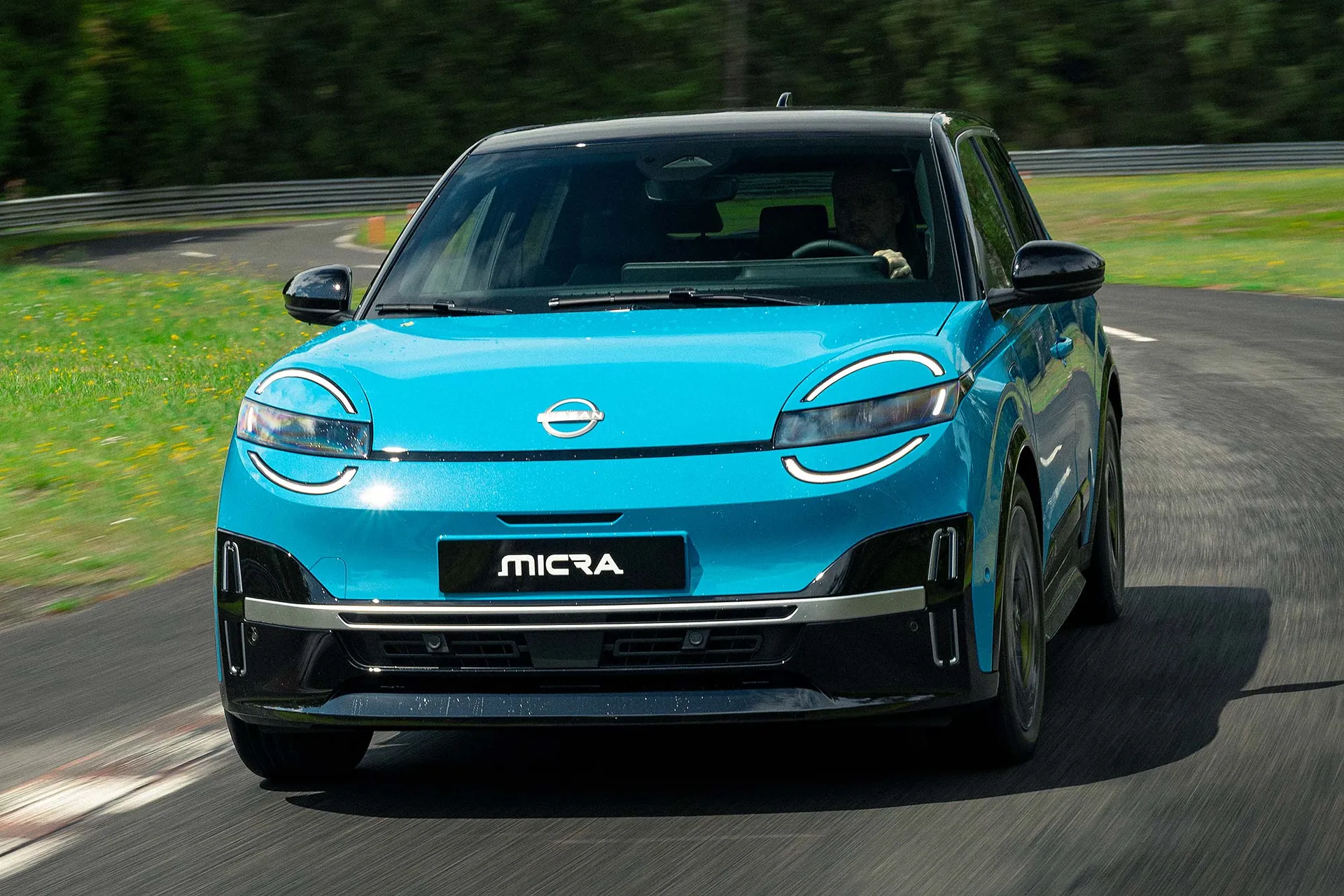
We’ve driven the 52kWh Nissan Micra, and were impressed by its efficiency. We reckon you should be able to average around four miles for each kWh of charge, which helps make charge cost calculations easy.
Taking the average home energy tariff of 26p per kWh, a zero-to-100% charge will cost £13.52. However, Nissan dealers will explain how you can sign up for a dedicated EV tariff, utilising much lower off-peak rates. At 10p per kWh, it would cost just £5 to fully charge a Nissan Micra battery.
Switch to public charging and things are much more expensive – this is why we’d stick with the 52kWh battery, so you can make more use of cut-price home charging. Taking the average 75p/kWh charge of a public charger, and going from 15-80% (adding 33.8kWh in the process) will cost just over £25. The Nissan Micra can rapid-charge at speeds of up to 100kW, meaning a 15-80% charge will take exactly 30 minutes.
Incidentally, although the 40kWh battery has a lower 80kW DC rapid charge speed, its smaller capacity means it still takes the same 30 minutes to go from 15-80%.
Nissan Micra reliability and warranty
Both Nissan and Renault fall into the lower half of the reliability rankings in the latest HonestJohn.co.uk Satisfaction Index – the two brands have an almost identical score. This means reliability may be middling, although Renault’s long experience in making affordable electric cars could give a lift to the Nissan Micra in due course.
All new Nissans have a three-year, 60,000-mile warranty. On top of this, the Nissan Micra electric adds an eight-year, 100,000-mile battery warranty, offering longer-term EV reassurance.
Nissan Micra insurance groups and costs
Nissan Micra insurance groups come in at group 19 for the 40kWh battery, and group 22 for the 52kWh alternative. This is a little higher than the norm for petrol-powered small cars, which generally start from group 11 or 12. It reflects the fact that electric cars can be a little more expensive to insure, although costs are falling all the time.
VED car tax: What is the annual road tax on a Nissan Micra?
As with all electric cars, the first-year road tax for a Nissan Micra is a cost-conscious £10. After this, it reverts to the standard £195 a year rate – sadly, electric cars no longer get cut-price VED road tax. At least it doesn’t have the additional £425 ‘luxury car tax’ for years two to six, thanks to list prices that remain under £40,000.
Nissan Micra price
”Prices for the new Micra start at £21,495 for the entry-level Engage model, rising to £23,495 for the Micra Advance. The top-spec Evolve model with the larger battery will set you back £28,365.”
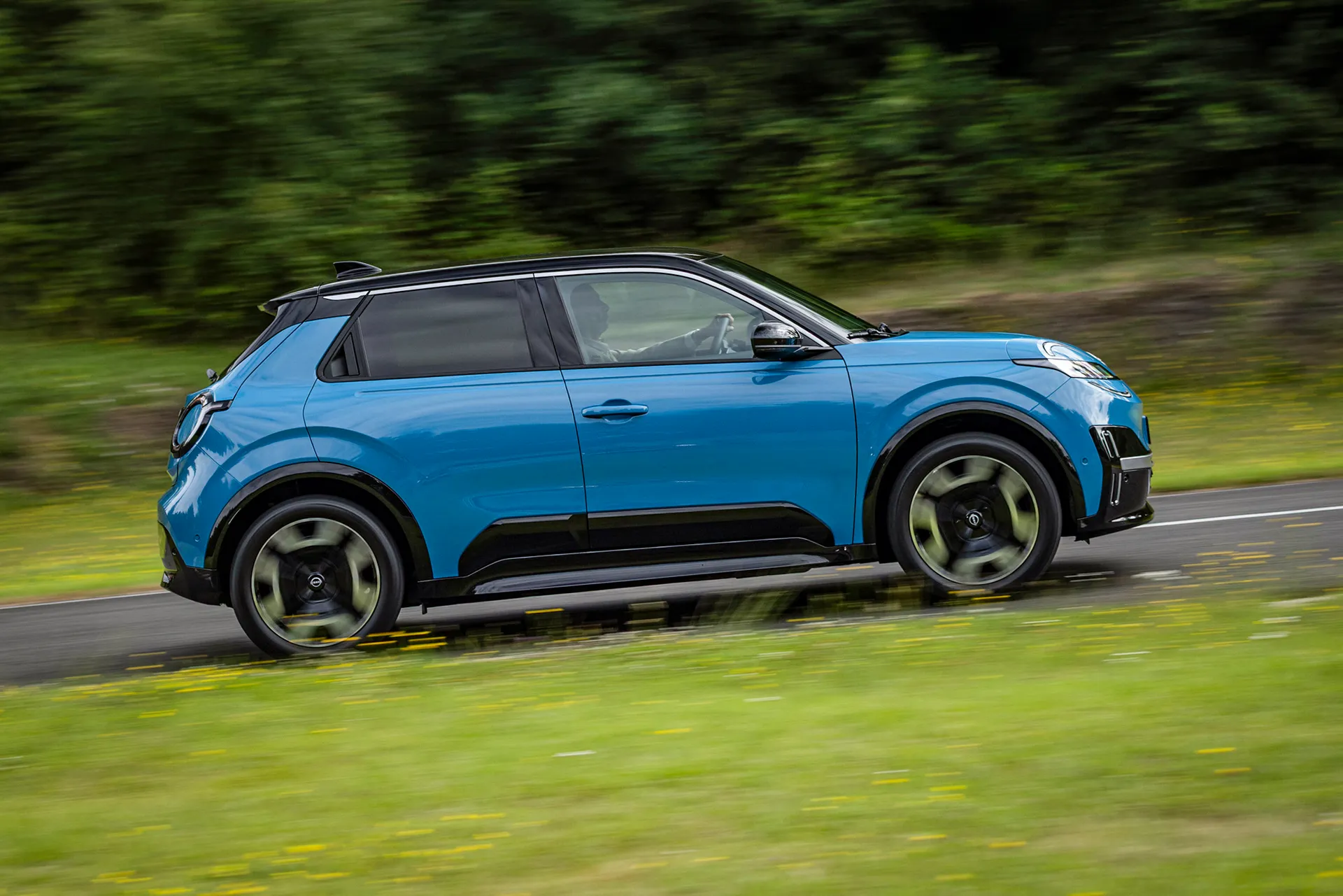
As we've touched on, the starting price is identical to the Renault 5 and £2,000 lower than the entry-level Hyundai Inster.
You can get the previous Nissan Micra for prices starting from well under £7000. For those not yet ready to make the switch to electric, it’s a solid petrol-powered choice.
Used Nissan Micra prices, for the previous 2017-2022 car, now start from well under £7000. This will get you a 1.0-litre petrol model in mid-range Acenta trim. If you want the 0.9-litre turbo engine, budget from around £8,000.
It's worth looking out for N-Connecta models. These have a desirable level of standard equipment including a feature-packed touchscreen system. Tekna models have a healthy list of standard features, too.
Trim levels and standard equipment
The Nissan Micra has a generous level of standard equipment even in entry-level Engage grade. Even this version has 18-inch alloy-look wheels, along with a 7.0-inch driver display and 10.1-inch infotainment screen, a four-speaker stereo and climate control air conditioning. Notably, an energy-saving heat pump is also standard, something that’s rare to find at this price level.
The Nissan Micra Advance replaces the alloy-look wheels with proper 18-inch ‘Iconic’ alloy wheels. The 10.1-inch infotainment screen now features the Google built-in tech, and there’s both a rear-view camera and front parking sensors. The stereo is upgraded to six speakers, while a wireless phone charger is included, along with adaptive cruise control that features ‘stop and go’ tech.
The Nissan Micra Evolve features an alterative 18-inch ‘Sport’ alloy wheel, and gets two-tone paint with a contrast roof colour. Inside, there’s the welcome addition of heated seats and steering wheel, a Harman Kardon premium sound system, and an even more advanced ProPilot Assist cruise control system with a link to the sat nav. The clever Nissan e-Pedal, which allows one-pedal driving, is included too, complete with paddleshifts on the steering wheel.
Ask the heycar experts: common questions
How much does the Nissan Micra cost?
How similar is the Nissan Micra to the Renault 5 E-Tech?
Is there a hot hatch version of the Nissan Micra?
Get our latest advice, news and offers
Keep me updated by email with the latest advice, news and offers from heycar.
By submitting you agree to our privacy policy
